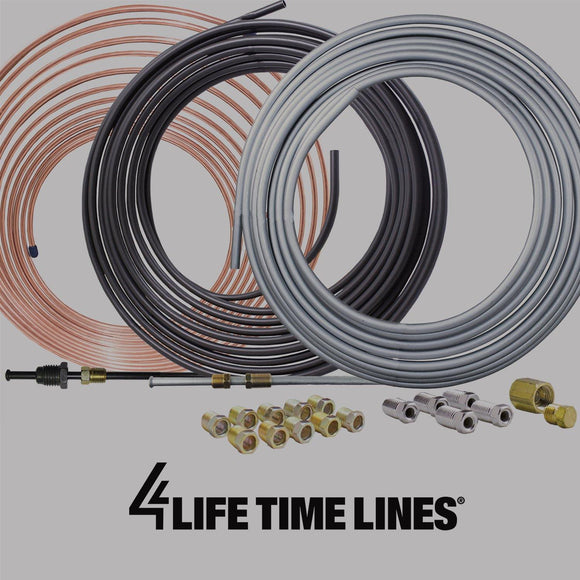
Brake Line Breakdown

The internet is full of things, and with more things on the internet, there's more noise. There are so many products and variations out there, each with its little permutations and handling characteristics; it's overwhelming. It's fun to take a deep dive on the internet to research a product, but there's just not enough time to sift through the massive amount of information available when. If you're here, you need brake lines that will last, and you need them now.
That's why we're writing this post.
The crew here at 4LifetimeLines loves working with the Automotive market, but we get it, brake lines aren't everything; it's likely the case that you weren't even thinking about brake lines until you had to make a sudden repair, so you need to figure out something that works-- and quick. No worries, though. We're going to cut to the chase and break down brake lines for you: what they do, what you need, and what's out there for you to install.
Functionally, brake lines are the conduits for brake fluid, which must withstand several thousand pounds of hydraulic pressure. They must also be able to withstand harsh environmental conditions and structural stressors: pressure cycling in the range of thousands of pounds, hammering from anti-lock brake (ABS) operation, and the constant bombardment of road salt, debris, and moisture from rustbelt roads. The hazards leveled against brake lines necessitate that they are made of a material that is strong enough to last and ductile enough to be maneuvered around across the full length of an automobile.
Moreover, brake lines make a lot of stops across the hydraulic braking system. Tubing runs between the master cylinder, calipers, wheel cylinders, and in some cases the proportioning valve and anti-lock brake modulator. With so many parts to run lines to, brake lines have to be cut and secured to the parts of the braking system with an easily-replicable technique. The industry standard is to fasten the lines at the ends with tube nuts. A technician will slide a nut onto the brake line, then flare the line to lock the tube nut onto the tubing. From there it's just a matter of screwing the tube nut onto the respective portion of the brake line subassembly, thus securing the line in place.
There are two basic types of passenger vehicle brake line flares: the double flare (also called the inverted flare) and the bubble flare (also known as the metric flare). It is important to know that these two flare forms are not interchangeable.
Brake tubing as used in passenger vehicle applications is most commonly 3/16”, 1/4". Infrequently you'll see a 6mm diameter. Many vehicles will use a combination of 3/16” and 1/4" tubing. As a general rule of thumb, the larger the diameter of the tubing the greater the flow rate will be for that tubing. Larger diameter tubing such as 5/16” and 3/8” are typically reserved for fuel, transmission, and cooling line applications.
The passenger vehicle industry has historically used their standard of steel tubing, which is made by rolling a copper-coated steel strip and furnace brazing it along the seam. When completed the steel tubing is double-walled for extra strength. This style of brake line is known as Bundy tubing and is zinc coated for rust resistance. Strong and relatively inexpensive to fabricate, Bundy tubing has for decades been the choice of vehicle manufacturing plants. Unfortunately, steel brake line tubing has proven itself susceptible to corroding under constant exposure to modern calcium chloride and “brine” road salt mixtures: once the zinc outer coating is bleached, steel lines rust and corrode quickly, making for a costly and inevitable repair.
Recently there has been a significant advancement in brake tubing: a seamless copper-nickel-iron blend, known commonly as copper-nickel alloy. You can read more about Copper-nickel's usage in brake lines here, but suffice our article on Copper-nickel to say that it's a miracle material. Copper-nickel alloy lines not only meet the pressure ratings and requirements for passenger vehicle applications but will not rust or corrode even in the harshest “rust belt” environments. Additionally, Copper-nickel bends and flares easily, and can be twisted around the innards of a car by hand. It also seats and seals to the component with much less force than steel line, and thus has become the preference of both the service professional and the DIY mechanic.

For each brake line described above, Steel, PVF coated or copper-nickel is commercially available in roll form in various lengths and diameters or in pre-flared and terminated sections called "sticks."
So there's your snapshot: a focused look at what a brake line needs to be in order to fit into the brake system, how they are attached to the subsystems, and what materials we think are the best options available for your next brake line replacement job. 4LTL offers every product above and then some. We love working with gearheads and automotive professionals, and we back that love up with our Limited Lifetime Warranty on every product we sell. If you've got lines to replace, we'd be happy to help. Did you enjoy reading our blog? If so, let us know by using promo code: BLOG10 at checkout and get 10% off of your order!
Best of luck with your next project,
The 4LTL team.

